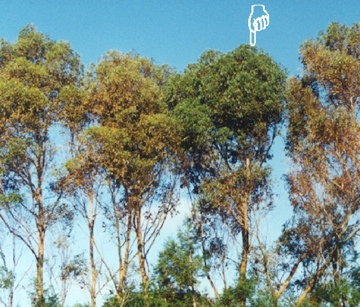PESTS AND DISEASES OF FORESTRY IN NEW ZEALAND
Cardiaspina resistant eucalypts
Scion is the leading provider of forest-related knowledge in New Zealand
Formerly known as the Forest Research Institute, Scion has been a leader in research relating to forest health for over 50 years. The Rotorua-based Crown Research Institute continues to provide science that will protect all forests from damage caused by insect pests, pathogens and weeds. The information presented below arises from these research activities.
From Forest Health News 87, July 1999.
 Eucalypts form a distinctive part of our landscape, so it's always sad to see stag-headed or dying trees. Dead ones are good for firewood, of course. Cardiaspina fiscella, the brown lace lerp, is doing more than its fair share of ravaging the very common eucalypts; E. botryoides and E. saligna . However, all is not lost. A sharp-eyed aborist on Auckland's North Shore spotted a 30m E. botryoides unaffected by the lerp. All the surrounding eucalypts have the classic scorched leaf appearance of brown lace lerp infestation. The tree's identity was confirmed by the Forest Research Herbarium and it is now to be protected in the event of the surrounding trees being felled. Another resistant specimen of E. botryoides was found last week while looking for the painted apple moth in west Auckland. This tree formed part of a shelter belt that was felled last year and all the stumps have coppiced vigorously. The leaves of one stump are completely untouched while all the others show typical symptoms. Resistance to pests probably exists in any population, but it's good to see it in a species so completely blitzed by this aggressive insect. Suitable natural predators of C.fiscella exist in Australia and with appropriate financial commitment the necessary research and risk assessments could be carried out. This would then allow an application for release to be made to the Environmental Risk Management Authority. As in the case of elms some of the largest landowners with unhealthy eucalypts are city and district councils, who potentially face large bills for felling unsafe trees. They may be interested in collaborating to fund such an application. Good forest health practises are considerably cheaper than removing dead trees in parks and reserves.
Eucalypts form a distinctive part of our landscape, so it's always sad to see stag-headed or dying trees. Dead ones are good for firewood, of course. Cardiaspina fiscella, the brown lace lerp, is doing more than its fair share of ravaging the very common eucalypts; E. botryoides and E. saligna . However, all is not lost. A sharp-eyed aborist on Auckland's North Shore spotted a 30m E. botryoides unaffected by the lerp. All the surrounding eucalypts have the classic scorched leaf appearance of brown lace lerp infestation. The tree's identity was confirmed by the Forest Research Herbarium and it is now to be protected in the event of the surrounding trees being felled. Another resistant specimen of E. botryoides was found last week while looking for the painted apple moth in west Auckland. This tree formed part of a shelter belt that was felled last year and all the stumps have coppiced vigorously. The leaves of one stump are completely untouched while all the others show typical symptoms. Resistance to pests probably exists in any population, but it's good to see it in a species so completely blitzed by this aggressive insect. Suitable natural predators of C.fiscella exist in Australia and with appropriate financial commitment the necessary research and risk assessments could be carried out. This would then allow an application for release to be made to the Environmental Risk Management Authority. As in the case of elms some of the largest landowners with unhealthy eucalypts are city and district councils, who potentially face large bills for felling unsafe trees. They may be interested in collaborating to fund such an application. Good forest health practises are considerably cheaper than removing dead trees in parks and reserves.
Chris Inglis, Forest Health Consultant
From Ensis publication Forest Health News 88, August 1999.
Chris Inglis's observations of Cardiaspina resistant eucalypts adds new locations to an already observed population of resistant trees in and around Auckland. I first started noting such Eucalyptus botryoides and E. saligna in mid 1997 and 1998 at Auckland Airport and in an orchard shelterbelt at Awhitu (Manukau Heads). These trees have the potential to form a nucleus of resistant parents for a breeding programme.
Chris Scott, Forest Research, Auckland
This information is intended for general interest only. It is not intended to be a substitute for specific specialist advice on any matter and should not be relied on for that purpose. Scion will not be liable for any direct, indirect, incidental, special, consequential or exemplary damages, loss of profits, or any other intangible losses that result from using the information provided on this site.
(Scion is the trading name of the New Zealand Forest Research Institute Limited.)



